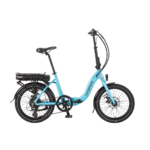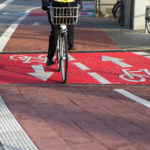Back in June I was on holiday in Brittany with some friends. We happened to spot a mature (circa. 1930!) gent about to get on an electric scooter. Being interested I engaged him in conversation.... bad move! Before you could say 'mais non' we were invited back to his place and were picking up the finer points of testing French wine! However, he was an electric bike enthusiast, lots of newspaper cutting of celebrities on bikes including Madam Royale, the then just defeated Presidential candidate.
He told us of an electric bike manufacturer 20 miles away, so next day, suitably sober we made a visit.
Wow.... the showroom attached to the small factory would have done justice to a BMW dealership. 20 + bikes of all options on display, a rolling road to test them, accessories etc. The owner/designer and his wife were very helpful giving me, in broken English that matched my even more broken French, lots of data.
The bike were superb, like Swiss watches, super light (20 kg. all up) and powered by two American motors behind the seat gripping on a special insert fitted into the wheel rim. Assistance limited to 15 mph, and at that speed a solenoid pulls the motors off the insert. His Battery claims were quite amazing. I quote from his notes (made on a bit of scrap paper I gave him).
Motor grip /efficiency, 60 to 70%. Whilst the friction drive technique is old hat, this is certainly a new way to apply it to the wheel.
25 volt 16 Ah Li ion battery, one charge gives up to 100km/62 miles (if no hills and some pedalling, 200km/124 miles !). One customer had apparently done 30,000km in two years!
Of course this quality costs money. However...2,500 euro (probably £1,700 ish) relates favorarably to our top end 'Chinese built' purchases, and the French price includes TVA at almost 20%.
Sorry, but It was not diplomatic for me to ask for a ride, as it was obvious we were just looking, and they knew it!
You may or may not like it, but it is different! SS.

http://users.tinyworld.co.uk/flecc/images/cybien.jpg
He told us of an electric bike manufacturer 20 miles away, so next day, suitably sober we made a visit.
Wow.... the showroom attached to the small factory would have done justice to a BMW dealership. 20 + bikes of all options on display, a rolling road to test them, accessories etc. The owner/designer and his wife were very helpful giving me, in broken English that matched my even more broken French, lots of data.
The bike were superb, like Swiss watches, super light (20 kg. all up) and powered by two American motors behind the seat gripping on a special insert fitted into the wheel rim. Assistance limited to 15 mph, and at that speed a solenoid pulls the motors off the insert. His Battery claims were quite amazing. I quote from his notes (made on a bit of scrap paper I gave him).
Motor grip /efficiency, 60 to 70%. Whilst the friction drive technique is old hat, this is certainly a new way to apply it to the wheel.
25 volt 16 Ah Li ion battery, one charge gives up to 100km/62 miles (if no hills and some pedalling, 200km/124 miles !). One customer had apparently done 30,000km in two years!
Of course this quality costs money. However...2,500 euro (probably £1,700 ish) relates favorarably to our top end 'Chinese built' purchases, and the French price includes TVA at almost 20%.
Sorry, but It was not diplomatic for me to ask for a ride, as it was obvious we were just looking, and they knew it!
You may or may not like it, but it is different! SS.

http://users.tinyworld.co.uk/flecc/images/cybien.jpg
Last edited:






